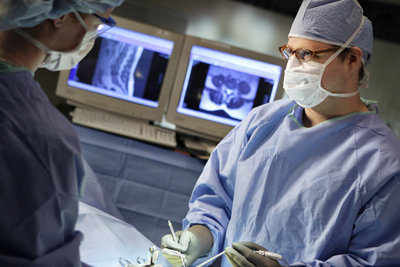Spine Surgery

At Aurora BayCare, our spine surgeons treat a range of spinal conditions from herniated discs to complex issues like scoliosis, tumors, and spinal fractures. Many conditions can be treated without surgery. But when surgery is necessary, you’ll find the latest, minimally invasive options at Aurora BayCare.
Minimally Invasive Spine Surgery
Minimally invasive surgery is an innovative way to treat spine conditions. Instead of cutting through muscle and bone, we can perform many spine surgeries using one small incision.
With minimally invasive surgery, we can perform the same procedures with less disruption to healthy bone and tissue. This means:
- Smaller incisions
- Less pain
- Less blood loss
- Shorter hospital stays
- Faster recovery
- Faster return to activities
We can treat most spine conditions. We use a broad range of procedures, including those listed below.
Laminectomy

A laminectomy involves removing the bone that forms the back part of the spinal column. It can be done to remove pressure from the nerves or spinal cord. This is also known as spinal decompression surgery. A laminectomy can involve a single or multiple levels of the spine. The procedure is a common surgical treatment for spinal stenosis.
Discectomy, Microdiscectomy
A discectomy is an operation done to treat a herniated lumbar disc. In a microdiscectomy, a small window is made in the bone over the nerve and disc and the portion of the disc that is compressing the nerve is removed.
A microdiscectomy is performed through a small incision in the back. Muscles are moved aside to allow the surgeon to see the bone. This procedure is often done on an outpatient basis.
This surgery is also known as herniated disc surgery.
ACDF Surgery
Anterior cervical discectomy and fusion (ACDF) is a surgical treatment for patients with cervical disc disease causing arm or neck pain. Anterior cervical fusions are also performed to treat cervical instability due to trauma (fractures or dislocations), tumors, infection or kyphosis - a deformity of the spine.
In an ACDF, an incision is made on the front of and to one side of the neck. An assistant gently protects the trachea (windpipe) and esophagus (the connection between the mouth and stomach) so that the surgeon can remove the disc. Removing the disc relieves pressure from the spinal nerve roots and spinal cord.
To maintain the space between the vertebrae, a graft is placed where the disc had been. The body will then fuse this area, growing new bone to join the two spinal vertebrae together. The fusion also helps to maintain adequate space for the decompressed spinal cord and/or nerve roots.
Depending on the condition being treated, this is also an outpatient procedure.
Lumbar Spinal Fusion
A lumbar spinal fusion will eliminate motion at a vertebral segment. This procedure is often used to treat low back pain from degenerative disc disease. It is also done to treat pain from an unstable spine as a result of a tumor, fracture, scoliosis or other deformity.
In a lumbar spinal fusion surgery, a degenerated disc may be replaced with a graft. The graft causes the two vertebrae segments to grow together into one bone, thereby eliminating motion and pain.
In many cases, lumbar spinal fusions are supported by implanting spinal hardware in the form of screws and rods to hold the spine still while the body "fuses" a bone graft.
Minimally Invasive Lumbar Fusion
Some patients can be treated effectively with a minimally invasive lumbar fusion. In this procedure, the surgeon uses different devices, which require a much smaller incision than a traditional spinal fusion, causing less trauma to the surrounding tissues. This typically results in a faster recovery for the patient.
SI Joint Fusion
Sacroiliac joint fusion (SI joint fusion) is a minimally invasive procedures used to treat chronic lower back and pelvic pain. Most people with SI joint pain can find relief with medication, physical therapy, and injections. If nonsurgical treatments don’t work, SI joint fusion surgery may help.
The sacroiliac (SI) joint is located in your pelvis. The sacrum is a big, triangle-shaped bone at the base of your bone, and the ilium is a bone in your hip. The SI joint is where these two bones meet. SI joint fusion connects these two bones together and stabilizes the joint. The goal is to reduce pain and improve function.
Second Opinions
If you’ve already had spine surgery but still have neck or back pain, don’t give up. Talk to a spine doctor at Aurora BayCare and get a second opinion. We have the area’s largest team of neurosurgeon spine specialists. That experience and expertise, combined with state-of-the-art resources at Aurora BayCare Medical Center, allows us to offer the safest, most effective treatment options.